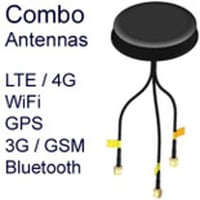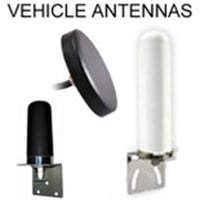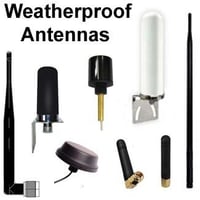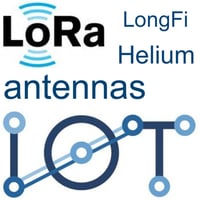Adhesive Mount Antennas
Adhesive Mount Antennas:
Adhesive mount antennas are antennas that are classified solely by their ability to be securely mounted using adhesives. The adhesives used for mounting these antennas may be in the form of pads, glue mounts, flat pads, or double-sided tape. The adhesive bond serves to connect the antenna to the surface it is installed on and hold it in place while withstanding the forces and stresses the installation will be subjected to, usually movement.
The use of an adhesive for mounting an antenna means that these antennas can be directly mounted on a variety of surfaces including metal, plastics, and glass without drilling or using a separate mount. The adhesive mount technique is convenient for easy and quick installation on mounting surfaces. However, the antenna will not be readily removed and may have lost its adhesiveness when it is remounted.
Adhesive mount antennas tend to be low-profile with the adhesive pad or surface spread over the majority of its area, making them easy to be mounted onto flat or slightly curved surfaces.
RoHS compliant adhesive mount antennas
All of the adhesive mount antennas featured here are manufactured to the highest standards using industry-approved materials and techniques. Our selection of adhesive antennas is fully compliant with key electrical and electronics sector legislation including:
- The Restriction of Hazardous Substances Directive (RoHS)
- The Conflict Minerals Regulation (2021)
- Section 1502 of the Dodd-Frank Act
These laws are concerned with restriction of the use of key hazardous materials (e.g. lead) from in electronics and clarifying the provenance of precious metals such as gold and tungsten, to ensure that they have not been procured using forced labor or exploitation.
Adhesive mount antennas are outdoor antennas
Adhesive antennas are commonly vehicle-mounted or used in marine settings. This means that they are continually exposed to temperature extremes, solar radiation, dust, dirt, and moisture that can ingress the antenna and cause corrosion and other damage. The casing of adhesive mount antennas is sealed to prevent this ingress and prolong the usable life of these antennas once they are mounted.
Many adhesive mount antennas carry an Ingress Protection Code (IP Code) from the International Electrotechnical Commission (IEC), which specifies the level of protection the antenna has against physical intrusion, dust, and moisture. Even with the IP67 rating, it is recommended to mount the antennas under an eave or overhang when using outdoors waterproof.
Adhesive mount antennas come in a range of designs
These antennas may be omnidirectional or directional. Types of adhesive mount antenna include:
[A] T-bar adhesive mount antennas
A T-bar antenna is a long, low-profile dipole antenna, with its feedline fitted at the center, much like a classic dipole. It is stuck down flat, forming a T-shape on the mounting surface. T-bar antennas are commonly used in vehicle tracking systems and cellular vehicle devices.
[B] I-bar adhesive mount antennas
The I-Bar antenna is a flattened cylinder that is mounted on its back using padded adhesive tape. This omnidirectional antenna houses either a patch antenna or dipole antenna in an IP67 rated plastic protective cover.
I-bar antennas connect to devices using a flexible coaxial cable (LMR-100 or RG174) that is usually terminated by RP-SMA connectors and exits from the base of the antenna.
[C] Adhesive mount patch antenna
Patch antennas are small, flat antennas that are easily mounted via an attached adhesive pad. They vary in shape and size but are usually square or rectangular pieces of metal that are mounted over a ground plane. They are a variation on micro-strip antennas produced in the 1970s and deliver good performance at microwave frequencies. As well as being mounted externally, they can be mounted on PCBs or integrated within devices.
Key applications of adhesive mount antennas
Due to the flexibility of their mounting, adhesive antennas prove advantageous in a range of applications and can be positioned for optimal performance.
- WiFi adhesive mount antennas
Adhesive mount WiFi antennas are used for WiFi networking and connectivity in a range of settings. The size and low-profile of these antennas mean that they can be discretely installed and deliver coverage in areas where accessibility is poor. The antennas are available to operate at both the standard 2.4 GHz frequency and the newer 5 GHz frequency band, meaning that they can also be integrated into the full range of 802.11 networks. Also, 2.4 GHz adhesive mount antennas can be used for Bluetooth and ZigBee networks.
- GPS adhesive mount antennas
Global Positioning System devices are a staple of navigation in vehicles and boats. This proprietary radio navigation system, created and owned by the United States Government, uses a constellation of 24 orbiting satellites to broadcast time and positional data that is used for navigation on earth.
The GPS signal broadcast by the satellites must pass through the layers of the earth's atmosphere which cause significant attenuation. GPS antennas, therefore, need to be suitably sensitive to the signal and have good exposure to the open sky to obtain a fix within a short period. A GPS antenna will not operate properly if it is used indoors or covered by the roof of a vehicle. Adhesive mounting makes it easy to secure a GPS antenna to a vehicle windshield where it will have the exposure required for optimal performance, especially while the vehicle is moving.
- Cellular adhesive mount antennas
Cellular antennas can be used to enhance 2G, 3G, and 4G/LTE cellular connectivity in a range of settings. They can be connected directly to cellular devices or used to improve coverage or call-quality by using a cellular booster. As cellular adhesive mount antennas can be securely mounted on glass, they can be positioned on windows and windshields for maximum exposure.
- Multi-band adhesive mount antennas
High-performance multiband antennas deliver connectivity for global cellular networking standards, GPS, and WiFi for up to 7 devices simultaneously. These dome or puck-shaped antennas have a broad base that is used for the adhesive attachment. By using a dual or multi-band antenna, fewer antennas are needed, meaning less space is used to mount the antenna.
Why are adhesive mount antennas important?
Adhesive mount antennas are vehicle antennas
Secure mounting is essential for mounting antennas on vehicles as they can be displaced or damaged by movement. Modern motor vehicles use not only radio but also a number of wireless networks for navigation, vehicle to vehicle (V2V), and vehicle to everything (V2X).
To perform optimally automobile-mounted antennas need to be positioned to be able to receive signals from all around the car. This usually involves mounting the antenna at height, or in another position that offers maximum exposure. The connecting cable for the antenna also needs to be kept as short as possible to minimize attenuation along its length. The position of an adhesive vehicle antenna should also be clear of obstructions, particularly metal, with a clearance area of approximately three times its size. Coupling with metal structures or other antennas on the vehicle should also be avoided.
Adhesive mount antennas are mobile antennas
Because of the secure, vibration, and jolt-proof hold of adhesive mount antennas, they are an antenna type that is useful for applications where mobility is required. These antennas are able to function optimally while a vehicle is in motion and are typically omnidirectional monopoles and dipoles which are capable of sending and receiving signals in all directions on the horizontal plane.
6 key benefits of adhesive mounting for antennas
Adhesives provide great flexibility and a secure hold for mounting antennas in a variety of settings. They are user-friendly and do not require technical expertise or equipment for installation. Other advantages of using an adhesive mount antenna for your application include:
- The antenna can be attached to a wider variety of surfaces. As long as the adhesive is able to bond and you have enough space for the footprint of the antenna, an adhesive-mount antenna can be mounted anywhere. This means you can position it wherever you can get the best signal without being constrained by the surface that is available.
- Compared to mechanical methods of mounting, adhesives provide great corrosion protection. Because the adhesive creates a strong sealed bond to the surface the antenna is mounted on, it resists the ingress of water and dust that would normally build up and degrade a mechanical mount.
- Adhesives mounts evenly distribute the weight and any physical forces across the antenna. Adhesive mount antennas are secured over an area rather than at a single point which distributes load stress across the entire antenna. This protects the antenna from wear in areas like where the antenna cable or connector is attached.
- Conventional mounting adds to the weight of the antenna installation. With an adhesive mount, the mounting is integrated with the antenna for a lightweight arrangement that can be secured on surfaces that could not accommodate the weight of a traditional antenna mount.
- Adhesive mounting works with flexible antennas that can withstand bending and vibration. The viscoelastic adhesives used for these antennas shrink minimally and have good cohesive strength meaning that they deliver good hold if a mobile antenna or vehicle-mounted antenna is secured in this way. As they absorb impacts, they also help the antenna resist fatigue with continued vibration or jolting.
- Adhesive mount antennas have a low-profile discrete appearance. If you require a high-performance antenna that is not bulky or obtrusive. Surfaces remain clear and free of screws and other protruding parts. The surface is also not penetrated by the mounting.
Adhesive-mount antennas are the key alternative to magnetic mount antennas.
Adhesive-mount antennas are often used for mounting antennas on vehicles. Mag-mount antennas are the main alternative to the adhesive-mount antenna as both offer a quick and simple solution to mounting an antenna on a vehicle or applications that require mobility without making a hole (through-hole mounting).
Adhesive mount antennas vs magnetic mount antennas:
- Adhesive mount antennas can be applied to ANY surface or part of a vehicle. Magnetic-mounts require ferric metals like steel and will not hold to aluminum. This makes the adhesive antenna a great alternative to mag-mounts.
- Adhesive-mount antennas have greater flexibility and can be securely mounted on curved surfaces like windshields
- Adhesive-mount antennas cover a greater surface area on the mounting surface, which is advantageous in applications like GPS where maximum exposure of the antenna to the open sky is desirable.
- Because the surface area of adhesive mount antennas is larger, they have a better hold and resistance to vibrations than mag-mounts, especially if a large antenna is mounted on a small mag-mount.
- Adhesive mount antennas are flat or low-profile whereas magnetic mount antennas tend to be tall monopole antennas screwed into a small base.
- Magnetic mounts rely on magnetism for their hold to a metal surface, whereas adhesive antennas use the bonding strength of their adhesive.
- Magnetic mount antennas may be easier to retrieve, depending on the strength of the bond of the adhesive antenna to its mounting surface.
- Magnetic mount antennas use the metal surface they are mounted on as a ground plane, via capacitive coupling.
How adhesive mounting works
The type and quality of adhesive will affect the level of bonding and sealing of the antenna as well as the longevity of the installation. Our range of adhesive antennas use adhesive from reputable manufacturers like 3M and have performance that is matched to their application and the varying surfaces and conditions in which they are used. This requires technical consideration of the surface energy, contour, and level of cleanliness of the surface the antenna will be mounted on.
Surface energy is a characteristic of materials that affects the ability of an adhesive to attach intimately and spread out across the mounting surface. Cleanliness has a big effect on surface energy, meaning that these antennas are best secured on pre-cleaned vehicle surfaces.
3M adhesive antennas use adhesive tape bondingor adhesive mounts for a superior hold. The adhesive on the antennas has excellent cohesive strength and is able to make intimate contact across the mounting surface. Dirty surfaces have lower surface energy meaning that the adhesive will not spread properly across the surface, bead up and be unable to form an adequate or durable bond.
The adhesives used for adhesive mount antennas also need to have excellent cohesive strength. This is the hold the adhesive mount has when subjected to stressors like vibration, shearing, pulling, and peeling. It is largely determined by the composition of the adhesive and will determine the hold the antenna has to the material it is attached to.
Many adhesive mount antennas are fitted with pads of Pressure Sensitive Adhesive (PSA) tape which consists of fully cured viscoelastic adhesive which holds to the surface when pressed down. Double coated foam tapes are often used which provide additional insulation and gap-filling properties. These tapes and pads carry a layer of PSA on each side of a layer of polyethylene or acrylic foam.
Frequently asked Questions:
What are the best positions for mounting an antenna on a vehicle?
The optimal positions for placement of an adhesive antenna will vary according to the vehicle design. It is prudent to test the antenna in a range of positions before finally sticking it down.
- Roof - offers height and is usually free from obstructions.
- Rear window - on-glass antennasare mounted using adhesives and are an effective alternative position to roof mounting.
- Trunk - has good exposure and enough room to hold several antennas.
- Wing mirrors - can have antennas mounted on the back of the mirror, or within the mirrors shell housing.
In conclusion
Adhesive mount antennas are a convenient solution for mounting an antenna anywhere on a vehicle. Adhesive mount antennas also can be easily mounted on walls, glass windows, and other non-metal surfaces. High-quality adhesives assure that the hold of the antenna to their mounting surface is secure. Even with the IP67 rating, it is recommended to mount the antennas under an eave or overhang when using outdoors.
LEARN MORE:
- Magnetic antennas
- Weatherproof and waterproof antennas
- Marine antennas
- Antenna mounting







